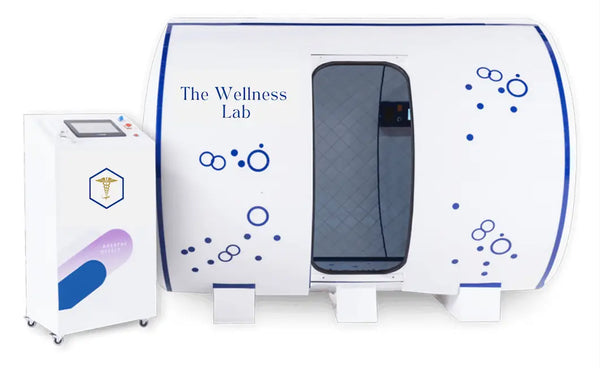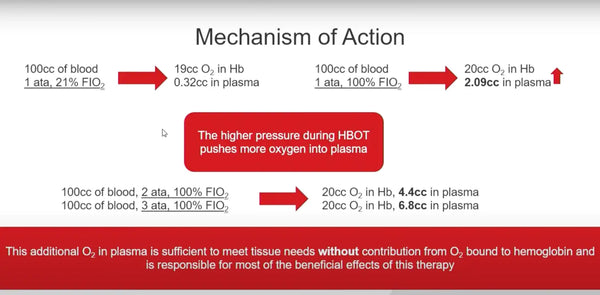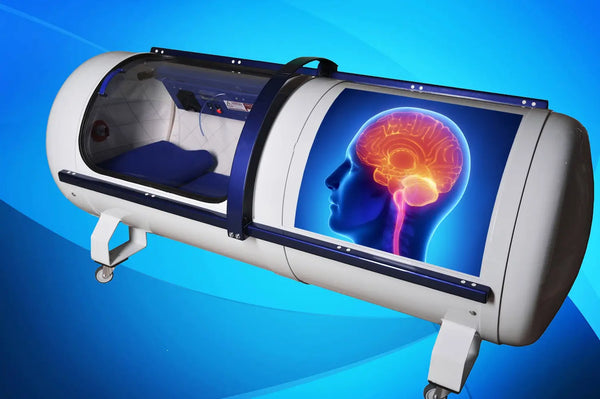Hyperbaric Oxygen is a novel type of regenerative biotechnology which utilizes the ideal gas laws, such as Henry’s, Boyle’s and Dalton’s to exert outstanding medicinal and therapeutic benefits which are unable to be accomplished by any other intervention, lifestyle or diet modification. Hyperbaric Oxygen is arguably one of the most exciting and versatile healing and anti-aging therapies of the modern-day. Hyperbaric Oxygen is extremely safe, drug-free and relaxing all at the same time. Additionally, it is non-invasive and painless. Hyperbaric Oxygen induces changes in oxygen availability which is one of the fundamental regenerative medicine paradigms.
“The fundamental cause of all degenerative disease is a condition called hypoxia (oxygen deprivation at the cellular level.)” - Dr Otto Warburg, Nobel Prize winner, 1931

Our bodies require energy for our daily activities, growth, healing and repair. This energy is fundamentally drawn from the oxygen we breathe and the nutrients we intake, which at the cellular level are transformed into adenosine triphosphate (ATP) at the final destination, the mitochondria. ATP is known as the universal energy currency, and every single cell in our body uses it to carry out important cellular processes and maintain systemic homeostasis.
In our everyday lives, we breathe in 21% oxygen at an atmospheric pressure level of 1 ata. At this state, if we take 100 cubic centimeters (cc) of blood, the amount of oxygen bound to hemoglobin is about 19cc and the amount of oxygen in the plasma is 0.32cc. During this state, our tissues and cells are solely relying on our circulatory system to deliver oxygen via hemoglobin.
However, more often than not, the needs of our tissues and cells are not fully being met by this method and our bodies begin to slip into a state of hypoxia (lack of oxygen) - which is the perfect condition for the manifestation of chronic disease.
When an individual enters a Hyperbaric Oxygen chamber, they breathe in 100% oxygen via an oxygen mask or a nasal cannula at an increased atmospheric pressure level (>1.5 ata).
As a result of the increased pressure, the oxygen particle becomes nanomized and is able to achieve greater solubility when entering the blood plasma, lymph and spinal fluid.
Clinical studies have demonstrated that Hyperbaric Oxygen can increase oxygenation of the blood plasma, spinal fluid and lymph by up to 10-15x greater than baseline.
In a Hyperbaric Oxygen chamber, taking 100cc of blood, the amount of oxygen bound to the hemoglobin is 20cc (not much of a change), but the amount of oxygen dissolved in the plasma is driven significantly higher to 4.4cc.
So now, the needs of our tissues, organs and cells can be met with the additional oxygen within the plasma.

Furthermore, the oxygen dissolved in the plasma holds the ability to pass through the many micro-occlusions, clots and capillary insults we acquire in our blood vessels throughout our lifetime. Meaning, the plasma can still flow through the damaged vessel, reach beyond the occlusion and deliver oxygen to support the tissues and cells that previously were oxygen deficit. This method of oxygen delivery cannot be accomplished by the circulatory system/hemoglobin alone.
These key points are believed to be what is responsible for most of the benefits seen in HBO. HBO creates an environment that is more conducive to healing.

Hyperbaric Oxygen and Our Epigenetics
Hyperbaric Oxygen has been demonstrated in several clinical studies to create long term change by modifying gene expression. HBO induces epigenetic changes within the body, resulting in the up-regulation of anti-inflammatory, growth and repair hormone genes, and the down-regulation of pro-inflammatory and apoptosis genes. Thus, Hyperbaric Oxygen is altering inflammatory gene expression in human cells. Analysis reveals up-regulation of antioxidant, cytoprotective and immediate early genes.
Results indicate that HBOT can change gene expression in a number of cellular pathways, including Nrf2, Integrin, and ERK/MAPK pathways. These pathways contain a number of genes that are critical in cellular defense. The functional significance of these gene expression changes is that HBO-treated cells are protected against an otherwise lethal oxidative stress.
Aging is characterized by the progressive loss of physiological capacity, and changes in gene expression can alter activity in defined age-related molecular pathways leading to cellular aging and increased aging disease susceptibility.
Mitochondria and Hyperbaric OxygenAt the cellular level, 80% of the available oxygen is used by the mitochondria, while only 20% is used by other organelles. Oxidative phosphorylation is the main source of energy in eukaryotic cells. As mentioned above, the end result of this process is the creation of ATP and our mitochondria are the structural organelle that mitigates the oxidative phosphorylation chain.
Hyperbaric Oxygen has been clinically proven to revitalize the mitochondria and increase ATP formation by providing supraphysiologic amounts of oxygen necessary for cellular respiration.
As mitochondria degeneration and dysfunction are thought to be two of the primary etiologies of aging and possibly cancer, these findings are significant to our everyday lives and health.
The diffusion gradient experienced in a Hyperbaric Oxygen chamber drives the oxygen from the plasma directly into the mitochondria – according to Henry’s Law, stating that the amount of dissolved oxygen is proportional to the oxygen partial pressure. Thus, the free dissolved fraction of oxygen now within the plasma has a dominant effect on the mitochondria.

As oxygen is now being directly supplied to the mitochondria, there is now an increase in ATP output, and consequently, surplus energy. For the most part, most of us have conditioned our bodies to be in survival mode, where there is a lack of energy supply and our mitochondria are not working most effectively. However, now that the body now has added extra energy, the body is able to use this energy to initiate many of the detoxification processes which were previously put on the ‘back foot’.
A recent study reported that HBO increased mitochondria biogenesis and autophagy through, in part, increased production of reactive oxygen species. Through this process, new healthy mitochondria were produced, and old dysfunctional mitochondria were destroyed. This study also found increased activation of mitochondria DNA transcription and replication.
~800% Increase in Circulating Stem Cells Mediated by Hyperbaric Oxygen, But How?
Hyperbaric Oxygen has been known to increase your circulating level of stem cells as you steadily undergo more sessions by up to ~800%, but what are the key mechanisms of action behind this?
You can view these stem progenitor cells as an intelligent 3D printer in the way that these stem cells can print whatever cell is needed for the body to repair.
The main trigger for stem cell proliferation is hypoxia, which means lack of oxygen. Once the body senses hypoxia and a lack of oxygen, the body is triggered into thinking there will be a 'problem' and starts to replicate stem cells.
However, just like anything in life, the body does not sense absolute values and, in fact, senses this hypoxia via delta fluctuations. Meaning that when an individual undergoes HBO, we can 'trick' the body into thinking it is undergoing hypoxia due to the fluctuations in oxygen concentration within the blood and the blood plasma.
For example, when an individual is taken to a very high atmospheric pressure level and receives 100% oxygen within the chamber, the body is hyper-oxygenated. However, when the chamber is decompressed, the oxygen level decreases, and the pressure decreases. This fast decline registers in the body as hypoxia as the individual has gone from a very high oxygen level to now low.
It is this key delta fluctuation that registers in the body as hypoxia. This is named the Hyperoxic-Hypoxic Paradox.
The pressure-sensitive and oxygen-sensitive genes within the mitochondria sense this paradox, which triggers stem progenitor cells' proliferation.
For a more in-depth analysis, short-term hypoxia mediated by Hyperbaric Oxygen can induce stem cell proliferation, migration, and differentiation capacity. In addition, this hypoxia also modulates the paracrine activity of stem cells, causing upregulation of various secreted factors, such as VEGF and exosomes, that also have important angiogenesis and anti-inflammatory effects. The mechanisms by which hypoxia exerts its effect on cells are mainly regulated by HIF-1 and related down-cascade protein expression.
Additionally, Nitric oxide plays a key role in triggering stem progenitor cell mobilization from the bone marrow via release of the stem cell active cytokine, cKit ligand (stem cell factor), as HBO can activate NO synthase in different tissues.
These stem cells mobilized by HBO home in on tissues that have suffered damage and signal a need for regeneration. HBO induces the differentiation of stem cells to the different tissues such as the heart, muscle, kidney and brain.
Telomeres, Senescent Cells and Hyperbaric Oxygen
A groundbreaking study from Tel Aviv University and the Shamir Medical Centre in Israel indicates that Hyperbaric Oxygen in healthy aging adults can stop the aging of blood cells and reverse the aging process.
In the biological sense, the adults’ blood cells grow younger as the sessions go on. The researchers found that Hyperbaric Oxygen can reverse two significant processes associated with aging and its illnesses: the shortening of telomeres (protective regions located at both ends of every chromosome) and the accumulation of old and malfunctioning cells in the body.
- The study discovered a lengthening of up to 38% of the telomeres
- As well as a decrease of up to 37% in the presence of senescent cells
“Telomere shortening is considered the ‘Holy Grail’ of the biology of ageing,” Professor Efrati says. His group utilised Hyperbaric Oxygen in only three months to elongate telomeres at rates far beyond any currently available interventions or lifestyle modifications. More evidence suggests that Hyperbaric Oxygen can reverse the ageing process at the basic cellular-molecular level.
Thus Hyperbaric Oxygen is looking to be a strong contender for a safe, non-invasive and side-effect free medical intervention that can address the unwanted consequence of age-related deterioration.
Hyperbaric Oxygen helps combat all degenerative ageing mechanisms by assisting the wounded cells of all the organs and tissues with the power of increased oxygen.
Considering that Hyperbaric Oxygen delivers a natural, endogenous substance (oxygen) to our body without any adverse side effects but with many significant medical benefits, including mending out DNA, it is easy to understand why HBO is a growing field of anti-ageing therapy.
Reduced Inflammation
Hyperbaric Oxygen has been clinically proven to reduce systemic inflammation. Hyperbaric Oxygen is excellent at reducing systemic inflammation within the body and reducing inflammation at the cellular level.
Studies have shown Hyperbaric Oxygen has a greater anti-inflammatory effect than steroids. Studies show c-reactive proteins and high levels of cytokines (both markers of chronic inflammation) can significantly decrease with Hyperbaric Oxygen.
In addition, Hyperbaric Oxygen has been shown to rebalance the immune system, increase energy levels and improve brain function.
Hyperbaric Oxygen is suggested to positively modulate the immune system and dampen the effects of the immune system self-attacking (as seen in autoimmune diseases and underactive thyroid).
Hyperbaric Oxygen has been shown to modulate T cells of the immune system, thus leading to a better clinical outcome. Research shows that HBO helps ameliorate both acute and chronic inflammatory conditions by reducing pro-inflammatory cytokine release.
HBO has been shown to suppress pro-inflammatory cytokine IL-6 and IL-1 family, thus having a direct therapeutic effect in many inflammatory diseases.
Enhanced Immune Function
HBO has been clinically proven to increase superoxide dismutase throughout the body.
Superoxide dismutase is one of the body’s most crucial free-radical scavengers and acts as a powerful antioxidant and detoxification enzyme within the cell.
HBO also increases the rate of phagocytosis within the body (the process of white blood cells fighting infections) and stimulates the process of apoptosis (killing the old or poor functioning immune or cancer cells). These steps are crucial for developing new cells, reducing inflammation and preventing chronic disease. Oxygen is a potent virucial and anti-microbial leading to improved inflection control.
Improved Your Cognitive Health
- Experience faster, sharper and stronger information processing
- Regress and halt your brain’s age
- Feel better, sleep better, be better
- Suppress age-associated diseases such as Alzheimer’s
Enhance The Way Your Body Feels
- Boost your immune system and anti-inflammatory response
- Restore your fitness levels
- Ramp up your sex drive
- Age with grace
- Improve your skin condition and health
Oxygen at the cellular level:
- The elixir of life – up to an 800% increase in stem cells
- Lengthen your telomeres and preserve your genetics
- Flood your mitochondria with oxygen and revive their function and health
- Clear your body of old and decaying senescent cells
This article is a guest post by: Jessica Sadd from The Wellness Lab in London.
Edited by: Olli Sovijärvi
Scientific references:
- Hadanny, A. and Efrati, S., 2020. The Hyperoxic-Hypoxic Paradox. Biomolecules, 10(6), p.958.
- Lippert, T. and Borlongan, C., 2019. Prophylactic treatment of hyperbaric oxygen treatment mitigates inflammatory response via mitochondria transfer. CNS Neuroscience & Therapeutics, 25(8), pp.815-823.
- Thom, S., Bhopale, V., Velazquez, O., Goldstein, L., Thom, L. and Buerk, D., 2006. Stem cell mobilization by hyperbaric oxygen. American Journal of Physiology-Heart and Circulatory Physiology, 290(4), pp.H1378-H1386.
- Kendall, A., Whatmore, J., Harries, L., Winyard, P., Smerdon, G. and Eggleton, P., 2012. Changes in inflammatory gene expression induced by hyperbaric oxygen treatment in human endothelial cells under chronic wound conditions. Experimental Cell Research, 318(3), pp.207-216.
- Godman, C., Joshi, R., Giardina, C., Perdrizet, G. and Hightower, L., 2010. Hyperbaric oxygen treatment induces antioxidant gene expression. Annals of the New York Academy of Sciences, 1197(1), pp.178-183.
- Zhou, Z., Daugherty, W., Sun, D., Levasseur, J., Altememi, N., Hamm, R., Rockswold, G. and Bullock, M., 2007. Protection of mitochondrial function and improvement in cognitive recovery in rats treated with hyperbaric oxygen following lateral fluid-percussion injury. Journal of Neurosurgery, 106(4), pp.687-694.
- Tezgin, D., Giardina, C., Perdrizet, G. and Hightower, L., 2020. The effect of hyperbaric oxygen on mitochondrial and glycolytic energy metabolism: the caloristasis concept. Cell Stress and Chaperones, 25(4), pp.667-677.
- Dave, K., Prado, R., Busto, R., Raval, A., Bradley, W., Torbati, D. and Pérez-pinzón, M., 2003. Hyperbaric oxygen therapy protects against mitochondrial dysfunction and delays onset of motor neuron disease in wobbler mice. Neuroscience, 120(1), pp.113-120.





